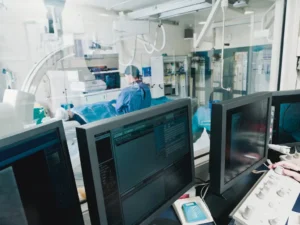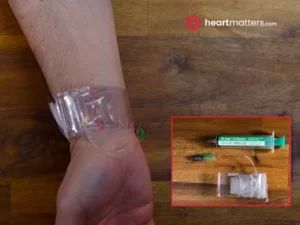Traditionally, coronary angiograms have been performed using the femoral artery in the groin region. However, an increasing number of cardiologists opt for radial artery access in the wrist due to several advantages. This approach is often more comfortable for patients during recovery. It is associated with fewer bleeding complications, primarily because the radial artery is smaller and more readily accessible in case pressure needs to be applied to control bleeding. In this article, we will discuss some important considerations of the procedure and the use of a small band-like device that helps compress the puncture site to prevent bleeding.
What is a Coronary Angiogram?
A coronary angiogram is a diagnostic procedure that uses X-ray imaging to examine the blood vessels that supply your heart with blood. During the procedure, a long, thin tube called a catheter is inserted into a blood vessel in your wrist (via the radial artery) or groin (via the femoral artery). The catheter is then threaded through the blood vessel to your heart. A special dye is injected into the catheter, allowing your cardiologist to visualize any blockages or other problems in your coronary arteries.

Inside a Cardiac Catheterization Laboratory (Cath Lab) – A view of the specialized room where coronary angiograms and other cardiac procedures are performed, showcasing the advanced medical equipment and technology used for diagnosing and treating heart conditions.
Procedure via the Radial Artery
A coronary angiogram performed via the radial artery is called a trans-radial coronary angiogram. It’s becoming more popular due to its lower risk of complications than the femoral (groin artery) approach.
Radial Artery Access – A close-up image highlighting the wrist area, where radial artery access is gaining popularity as an alternative route for coronary angiograms and interventions, offering potential advantages in patient comfort and recovery.
After the Procedure
Pressure Bandage/Wristband:
After the procedure, a pressure bandage is applied to the puncture site to prevent bleeding. The bandage is inflated with a syringe, gently pressing on the puncture site. Healthcare staff closely monitor it post-procedure, gradually releasing air to stabilize the area and prevent bleeding. This meticulous process promotes proper healing and reduces the risk of complications.

Rest:
Rest is an essential part of your post-procedure care. You will typically be asked to rest a few hours after the angiogram. This precautionary measure helps prevent bleeding from the catheter insertion site and promotes a smooth recovery.
Pain Relief:
Occasionally, you may experience discomfort or mild pain in your wrist or arm after the procedure. This discomfort is usually manageable. Your healthcare provider may recommend over-the-counter pain relief medication to help alleviate any pain you experience. Ensuring your comfort during recovery is an important aspect of post-procedure care.
Monitoring:
Your healthcare team will closely monitor your vital signs during recovery. This includes regular checks of your heart rate, blood pressure, and oxygen levels. Monitoring is essential to ensure you remain stable as your body recovers from the procedure.
Diet and Physical Activity:
After the radial artery angiogram, you’ll typically be able to resume your regular diet and hydration. There are usually no dietary restrictions. However, your healthcare provider may advise you to avoid strenuous physical activities and heavy lifting for a specified period to prevent any strain or complications related to the procedure.
Follow-Up:
Following the procedure, scheduling a follow-up appointment with your healthcare provider is crucial. You can discuss the angiogram results and any necessary next steps during this appointment. Your doctor will direct your ongoing care and recommend any additional tests or treatments based on the procedure’s findings.
Going Home:
After the radial artery angiogram, the duration of your hospital stay may vary based on your specific situation and procedure results. Sometimes, it’s possible to have a same-day procedure and return home. However, if you require additional interventions, such as percutaneous coronary intervention (PCI), or if specific medical reasons necessitate it, the possibility of staying at least one night for observation and post-procedure care arises.
Notably, there’s growing momentum in healthcare for same-day PCI in less complex cases. This depends on proximity to the hospital, having a companion, and transportation arrangements. It also assumes no post-procedure complications.
Your healthcare team will assess your case and guide you to return home the same day or stay overnight. Your safety and well-being will be the priority for a smooth transition to your routine.
Driving After the Procedure:
Typically, healthcare providers recommend refraining from driving for at least two days after an elective procedure. Your healthcare team will provide advice relevant to you following the procedure.
This precaution is primarily related to the potential discomfort and limitations in hand and leg mobility, especially if the procedure involves access via the femoral artery in the groin region. Activities such as using your hand to operate the steering wheel or gear stick and utilizing foot brake pedals can be temporarily challenging due to the puncture site’s location. These factors may impact your ability to drive safely immediately after the procedure.
To ensure your safety and the safety of others on the road, it’s crucial to adhere to the recommended period of refraining from driving as advised by your healthcare provider. This will allow you adequate time to recover, regain full mobility, and ensure you can operate a vehicle without discomfort or limitations. Always prioritize safety when it comes to post-procedure activities, including driving.
The period after a radial artery angiogram involves careful monitoring, pain management, and adherence to medical instructions to ensure a successful and complication-free recovery. This comprehensive post-procedure care promotes comfort and well-being as you progress toward better heart health.

Conclusion
In summary, the recovery process after an angiogram is a structured path to better health. Your healthcare team prioritizes your comfort and safety, overseeing your progress from initial monitoring to the gradual return to daily activities. Following their expert guidance, including wristband care, driving restrictions, and attending follow-up appointments, empowers you to recover smoothly and enhances heart health.











